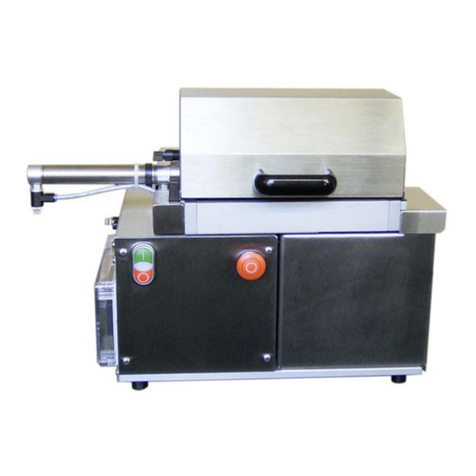23
GENERAL POWER TOOL SAFETY WARNINGS
WARNING READ ALL SAFETY WARNINGS AND ALL INSTRUCTIONS. Failure to
followthewarningsandinstructionsmayresultinelectricshock,fireand/orseriousinjury.Save
allwarningsandinstructionsforfuturereference.The term “power tool” in the warn-
ingsreferstoyour mains-operated (corded) power tool or battery-operated (cordless) power tool.
PERSONAL SAFETY
WORK AREA SAFETY
ELECTRICAL SAFETY
•Keep work area clean and well lit. Cluttered or
dark areas invite accidents.
•Do not operate power tools in explosive atmos-
pheres, such as in the presence of flammable
liquids, gases or dust. Powertoolscreatesparks
which may ignite the dust or fumes.
•Keep children and bystanders away while
operating a power tool. Distractions can cause
you to lose control.
•Power tool plugs must match the outlet. Never
modify the plug in any way. Do not use any
adapter plugs with earthed (grounded) power
tools. Unmodified plugs and matching outlets will
reduce risk of electric shock.
•Avoid body contact with earthed or grounded
surfaces such as pipes, radiators, ranges and
refrigerators. Thereisanincreasedriskofelectric
shock if your body is earthed or grounded.
•Do not expose power tools to rain or wet condi-
tions. Water entering a power tool will increase
the risk of electric shock.
•Do not abuse the cord. Never use the cord for
carrying, pulling or unplugging the power tool.
Keep cord away from heat, oil, sharp edges
or moving parts. Damaged or entangled cords
increase the risk of electric shock.
•When operating a power tool outdoors, use an
extension cord suitable for outdoor use. Use
of a cord suitable for outdoor use reduces the risk
of electric shock.
•If operating a power tool in a damp location is
unavoidable, use a ground fault circuit inter-
rupter (GFCI) protected supply. Useofan GFCI
reduces the risk of electric shock.
•Remove any adjusting key or wrench before
turning the power tool on. Awrench or a key left
attached to a rotating part of the power tool may
result in personal injury.
•Do not overreach. Keep proper footing and
balance at all times. This enables better control
of the power tool in unexpected situations.
•Dress properly. Do not wear loose clothing or
jewellery. Keep your hair, clothing and gloves
away from moving parts. Loose clothes, jewel-
lery or long hair can be caught in moving parts.
•If devices are provided for the connection of
dust extraction and collection facilities, ensure
these are connected and properly used. Useof
dust collection can reduce dust-related hazards.
POWER TOOL USE AND CARE
•Do not force the power tool. Use the correct
power tool for your application. The correct
power tool will do the job better and safer at the
rate for which it was designed.
•Do not use the powertooliftheswitchdoesnot
turn it on and off. Any power tool that cannot be
controlled with the switch is dangerous and must
be repaired.
•Disconnect the plug from the power source
and/or the battery pack from the power tool
before making any adjustments, changing
accessories, or storing power tools. Such pre-
ventivesafetymeasures reduce the risk ofstarting
the power tool accidentally.
•Store idle power tools out of the reach of chil-
dren and do not allow persons unfamiliar with
the power tool or these instructions to operate
the power tool. Powertools are dangerousin the
hands of untrained users.
•Maintain power tools. Check for misalignment
or binding of moving parts, breakage of parts
and any other condition that may affect the
power tool’s operation. If damaged, have the
power tool repaired before use. Manyaccidents
are caused by poorly maintained power tools.
•Keep cutting tools sharp and clean. Properly
maintained cutting tools with sharp cutting edges
are less likely to bind and are easier to control.
•Use the power tool, accessories and tool bits
etc. in accordance with these instructions, tak-
ing into account the working conditions and
the work to be performed. Use of the power tool
for operations different from those intended could
result in a hazardous situation.
•Stay alert, watch what you are doing and use
common sense when operating a power tool.
Do not use a power tool while you are tired or
under the influence of drugs, alcohol or medi-
cation. A moment of inattention while operating
power tools may result in serious personal injury.
•Use personal protective equipment. Always
wear eye protection. Protective equipment such
as dust mask, non-skid safety shoes, hard hat, or
hearingprotection used for appropriateconditions
will reduce personal injuries.
•Prevent unintentional starting. Ensure the
switch is in the off-position before connecting
to power source and/or battery pack, picking
up or carrying the tool. Carryingpowertools with
yourfingeron the switch orenergisingpower tools
that have the switch on invites accidents.
SERVICE
•Have your power tool serviced by a qualified
repair person using only identical replacement
parts. Thiswill ensure that thesafety of the power
tool is maintained.
SPECIFIC SAFETY RULES
Cutting procedures
• DANGER: Keep hands away from cutting
area and the blade. Keep your second hand
on auxiliary handle, or motor housing. If both
hands are holding the saw, they cannot be cut by
the blade.
•Do not reach underneath the workpiece. The
guardcannot protect you from thebladebelowthe
workpiece.
•Adjust the cutting depth to the thickness of
the workpiece. Less than a full tooth of the blade
teeth should be visible below the workpiece.
•Never hold piece being cut in your hands or
across your leg. Secure the workpiece to a
stable platform. It is important to support the
work properly to minimize body exposure, blade
binding, or loss of control.
•Hold the power tool by insulated gripping
surfaces only, when performing an operation
where the cutting tool may contact hidden
wiring or its own cord. Contact with a “live” wire
will also make exposed metal parts of the power
tool “live” and could give the operator an electric
shock.
•When ripping, always usearipfenceorstraight
edge guide. This improves the accuracy of cut
and reduces the chance of blade binding.
•Always use blades with correct size and shape
(diamond versus round) of arbour holes.
Blades that do not match the mounting hardware
of the saw will run eccentrically, causing loss of
control.
•Never use damaged or incorrectbladewashers
or bolt. Thebladewashersand bolt were specially
designed for your saw, for optimum performance
and safety of operation.
Further safety instructions for all saws
Kickback causes and related warnings
– Kickback is a sudden reaction to a pinched,
bound or misaligned saw blade, causing an un-
controlledsaw to liftup and outof the workpiece
toward the operator;
– When the blade is pinched or bound tightly by
the kerf closing down, the blade stalls and the
motorreactiondrivestheunitrapidlybacktoward
the operator;
– If the blade becomes twisted or misaligned in
the cut, the teeth at the back edge of the blade
can dig into the top surface of the wood causing
the blade to climb out of the kerf and jump back
toward the operator.
Kickback is the result of saw misuse and/or incor-
rect operating procedures or conditions and can
be avoided by taking proper precautions as given
below:
•Maintain a firm grip with both hands on the
saw and position your arms to resist kickback
forces. Position your body to either side of the
blade, but not in line with the blade. Kickback
could cause the saw to jump backwards, but kick-
back forces can be controlled by the operator, if
proper precautions are taken.
•When blade is binding, or when interrupting
a cut for any reason, release the trigger and
hold the saw motionless in the material until
the blade comes to a complete stop. Never
attempt to remove the saw from the work or
pull the saw backward while the blade is in
motion or kickback may occur. Investigate and
take corrective actions to eliminate the cause of
blade binding.
•When restarting a saw in the workpiece, centre
the saw blade in the kerf and check that saw
teeth are not engaged into the material. If saw
blade is binding, it may walk up or kickback from
the workpiece as the saw is restarted.
•Support large panels to minimise the risk of
blade pinching and kickback. Largepanelstend
to sag under their own weight. Supports must be
placed under the panel on both sides, near the
line of cut and near the edge of the panel.
•Do not use dull or damaged blades. Unsharp-
ened or improperly set blades produce narrow
kerf causing excessive friction, blade binding and
kickback.
•Blade depth and bevel adjusting locking levers
must be tight and secure before making cut. If
bladeadjustment shifts while cutting, itmaycause
binding and kickback.
•Use extra caution when sawing into existing
walls or other blind areas. The protruding blade
may cut objects that can cause kickback.
Lower guard function
•Check lower guard for proper closing before
each use. Do notoperatethesawiflower guard
does not move freelyandcloseinstantly. Never
clamp or tie the lower guard into the open
position. If saw is accidentally dropped, lower
guardmay be bent. Raise thelowerguard with the
retracting handle and make sure it moves freely
and does not touch the blade or any other part, in
all angles and depths of cut.
•Check the operation of the lower guard spring.
If the guard and the spring are not operating
properly, they must be serviced before use.
Lower guard may operate sluggishly due to dam-
aged parts, gummy deposits, or a build-up of
debris.
•Lower guard should be retracted manually
only for special cuts such as “plunge cuts”
and “compound cuts.” Raise lower guard by
retracting handle and as soon as blade enters the
material, the lower guard must be released. For
all other sawing, the lower guard should operate
automatically.
•Always observe that the lower guard is cov-
ering the blade before placing saw down on
bench or floor. An unprotected, coasting blade
will cause the saw to walk backwards, cutting
whateverisinitspath. Be aware of the time it takes
for the blade to stop after switch is released.
•Maintain labels and nameplates. These carry
important information. If unreadable or missing,
contact a MILWAUKEE service facility for a free
replacement.
•WARNING Some dust created by power sanding,
sawing, grinding, drilling, and other construction
activities contains chemicals known to cause
cancer, birth defects or other reproductive harm.




















